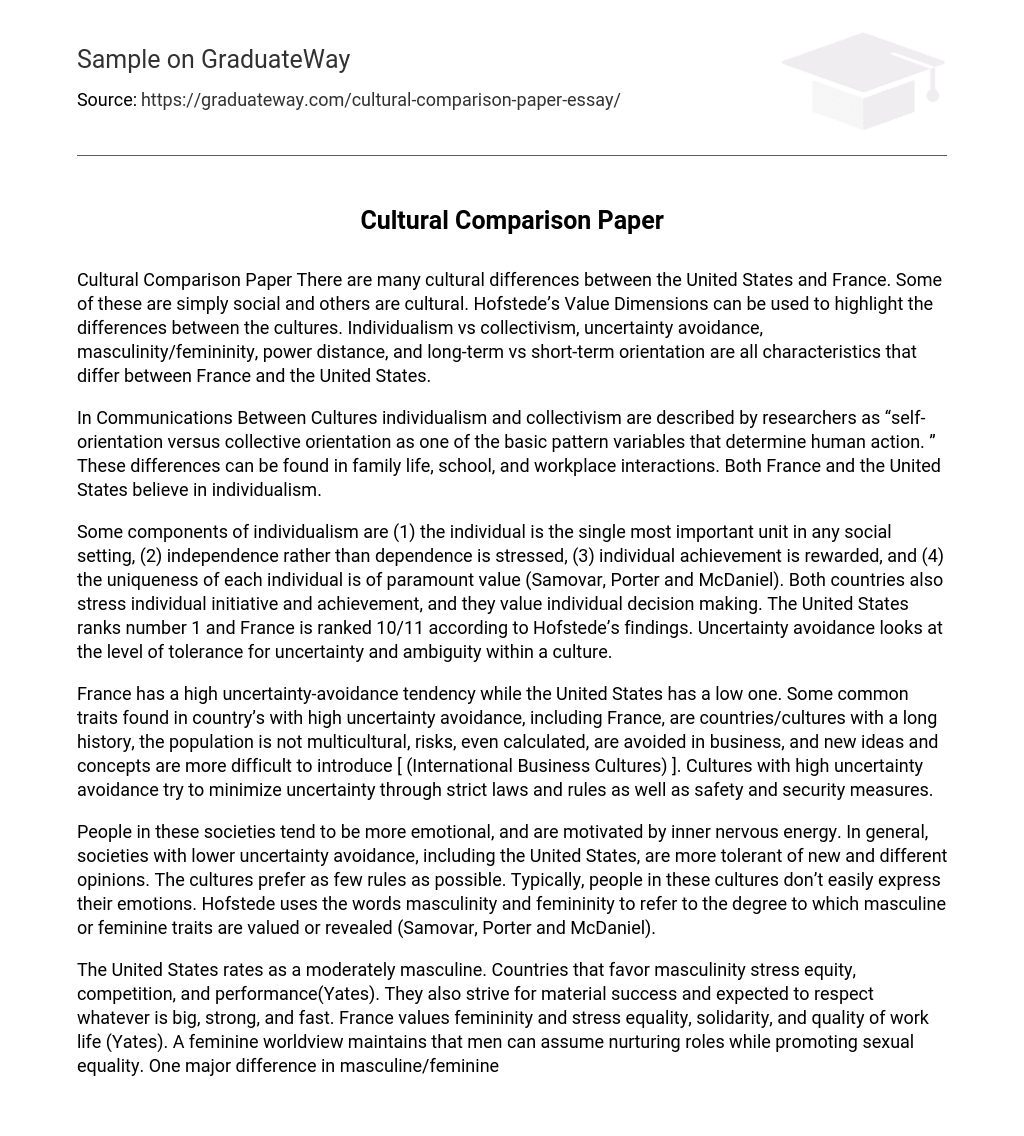The cultural disparities between the United States and France encompass social and cultural aspects. Hofstede’s Value Dimensions provide a framework to emphasize these disparities. Individualism vs collectivism, uncertainty avoidance, masculinity/femininity, power distance, and long-term vs short-term orientation all depict the differing characteristics of France and the United States.
According to researchers, the book Communications Between Cultures explains individualism and collectivism as “self-orientation versus collective orientation,” which heavily influences human behavior. These variations can be observed in various aspects such as family life, school, and workplace interactions. Both France and the United States endorse individualism.
The concept of individualism encompasses several elements: the individual is considered the central entity in any social environment, emphasis is placed on independence instead of reliance on others, recognition and rewards are given for individual accomplishments, and the distinctive qualities of each person are highly prized. Both the United States and France prioritize individual initiative, excellence, and decision-making. In accordance with Hofstede’s research, the United States is ranked as number 1 while France falls at position 10 or 11. Uncertainty avoidance looks at a culture’s capacity to handle and tolerate uncertainty and ambiguity.
France demonstrates a high inclination to avoid uncertainty, while the United States exhibits a low inclination. Common characteristics associated with countries or cultures that have a strong uncertainty avoidance tendency, like France, include a long history, a non-multicultural population, avoidance of risks (even when calculated) in business ventures, and challenges in introducing new ideas and concepts. Cultures with high uncertainty avoidance strive to minimize uncertainty by implementing stringent laws, rules, and safety measures.
In societies with lower uncertainty avoidance, such as the United States, people tend to be more emotional and are driven by inner nervous energy. These cultures prioritize tolerance for new and diverse opinions and favor minimal rules. It is common for individuals in these societies to not openly display their emotions. Hofstede’s terminology of masculinity and femininity pertains to the extent to which masculine or feminine qualities are esteemed or displayed.
The United States is considered to have a modest level of masculinity. In masculine countries, there is an emphasis on fairness, competition, and achievement. These societies also strive for wealth and admire qualities associated with size, strength, and speed. On the other hand, France values femininity and emphasizes equality, unity, and the quality of one’s work-life balance. A feminine perspective believes that men can take on nurturing roles while advocating for sexual equality. One significant contrast between masculine and feminine cultures lies in the role of women both in their professional lives and in their homes.
Feminine societies expect women to work and often provide the necessary social support systems. Despite the United States being more masculine compared to France, both countries view females as equals. Power distance defines the gap between power and members of a specific culture. France exhibits a higher power distance than the United States. Gudykunst describes countries with high power distance as those where individuals accept power as an integral part of society. Consequently, superiors perceive their subordinates as different from themselves and vice versa. In contrast, French people believe power and authority are fundamental aspects of life. This starkly contrasts with the low power distance in the United States. Americans consider themselves close to power and believe they should have immediate access to it. Subordinates perceive superiors as equals, and superiors view subordinates similarly. The long-versus short-term orientation dimension appears to be rooted in ideas reminiscent of Confucius’ teachings on both ends.
The text presents a comparison between long-term and short-term aspects of Confucian thinking, contrasting persistence and thrift with personal stability and respect for traditions. France, as an example, highly values long-term orientation, persistence, and the order of relationships based on status and observance of order and thrift, while also emphasizing a sense of shame. On the other hand, the United States values short-term orientation, personal steadiness and stability, protection of one’s reputation (‘face’), respect for tradition, and reciprocal gestures such as greetings, favors, and gifts. Despite both countries sharing a belief in individualism, they differ significantly in other areas. France exhibits high uncertainty avoidance, favors femininity, has a high power distance, and places a strong emphasis on long-term orientation. In contrast, the United States has low uncertainty avoidance, favors masculinity, has a low power distance, and prioritizes short-term orientation.





